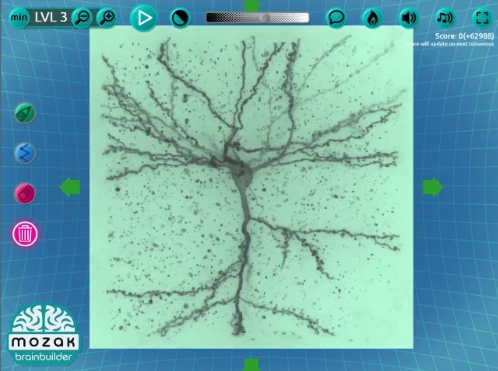Thursday, 18 April 2019
Online Game Advances Neuroscientific Research
 Five years ago, I wrote a post in this blog about a website called EyeWire, on which Dr. Sebastian Seung and his laboratory enlisted the help of the general public to colour the extensions (axons and dendrites) of neurons on various thin, sequential slices of nerve tissue. The lab then used the results to reconstruct each neuron in 3D on a computer. Today I want to tell you about the Mozak project, which has the same objective of reconstructing neurons in 3D. But where Dr. Seung’s EyeWire project dealt only with ganglion neurons in the retinas of mice, the Mozak project deals with neurons from various parts of the brains of various animals.
Five years ago, I wrote a post in this blog about a website called EyeWire, on which Dr. Sebastian Seung and his laboratory enlisted the help of the general public to colour the extensions (axons and dendrites) of neurons on various thin, sequential slices of nerve tissue. The lab then used the results to reconstruct each neuron in 3D on a computer. Today I want to tell you about the Mozak project, which has the same objective of reconstructing neurons in 3D. But where Dr. Seung’s EyeWire project dealt only with ganglion neurons in the retinas of mice, the Mozak project deals with neurons from various parts of the brains of various animals.
The Mozak project does, however, employ the same strategy as EyeWire. It gets human beings to play a game in which they exercise their judgment to determine the continuity (or lack of continuity) of axons and dendrites, because computers still make too many mistakes when they attempt this difficult task. The methods that Mozak uses to visualize these neurons, the interface that it uses to show them to players, and the tracing tools that it provides are different from EyeWire’s, but the objective is the same: to build a database of neurons in 3D with the hope of eventually classifying them into various categories and relating their forms to their functions (how they integrate and transmit nerve signals).
Because if we keep building large-scale functional models of the brain, or models of more localized neural circuits based on typical neurons, but continue to ignore the fine details of the branchings of actual neurons and their actual morphology, we will still be missing the most important aspect of the connectome—the map that scientists hope to make of all the neural connections in the brain. In one sense, though, the connectome will always remain a somewhat theoretical concept, because the fine connections that the neurons make with one another are constantly changing. (This synaptic plasticity is the basis for all learning.) Hence the detailed connectome of an individual’s brain on the synaptic scale at any given time in his or her life will never be the same a year or even just a day later.
Nevertheless, being able even to start to visualize, on this microscopic scale, the astonishing variety of forms of these small cells with branches as extensive as a tree’s can tell neurobiologists a great deal about the types of relationships that these cells have with one another. Playing the Mozak game also teaches non-scientists that neurons come in a greater variety of forms than is commonly believed. For example, some neurons have an apical dendrite, while others do not; some dendrites have spines, while others do not; and some axons even emerge not from the cell body but rather from the base of a large dendrite! These are just some of the things that you can observe when you get your head out of the textbooks and immerse yourself in the somewhat messy reality of actual neurons.
And besides, I love the idea that anyone can volunteer the 86 billion neurons in their brain to help scientists learn more about a few of them.
From the Simple to the Complex | No comments







